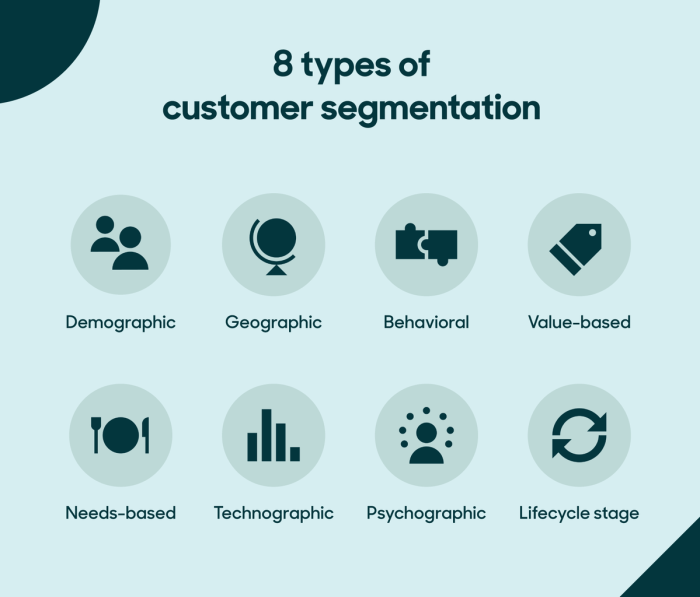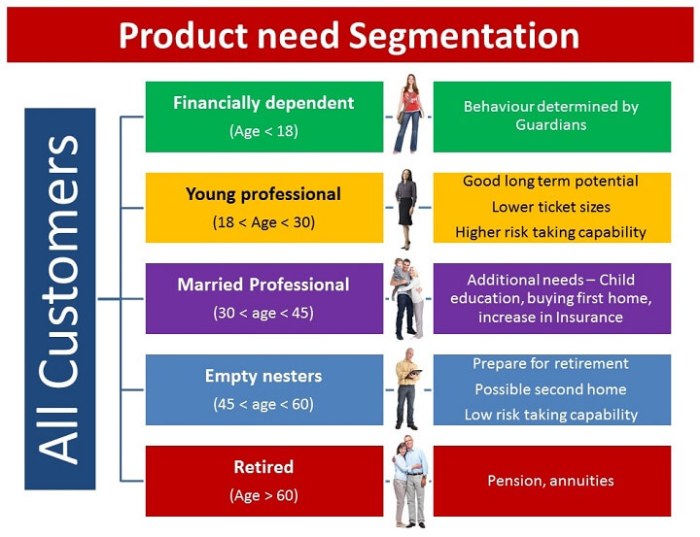Understanding Customer Segmentation dives into the art of categorizing consumers to boost marketing efforts. Get ready to explore the world of tailored products and personalized services!
In this digital age, knowing your customers inside and out is key to standing out in the market. Let’s uncover the secrets behind customer segmentation strategies used by successful businesses.
Understanding Customer Segmentation
Customer segmentation is the practice of dividing a customer base into groups of individuals that are similar in specific ways relevant to marketing, such as age, gender, interests, spending habits, and more. This allows businesses to tailor their products and services to meet the unique needs of each segment, resulting in more effective marketing strategies and increased customer satisfaction.
Types of Customer Segmentation Strategies
- Demographic Segmentation: Dividing customers based on demographics such as age, gender, income, education, and occupation.
- Psychographic Segmentation: Grouping customers based on their lifestyle, interests, values, and personality traits.
- Behavioral Segmentation: Segmenting customers based on their purchasing behavior, usage patterns, loyalty, and benefits sought.
- Geographic Segmentation: Dividing customers based on their location, such as country, region, city, or climate.
Customer segmentation helps businesses in tailoring products and services to meet specific customer needs by allowing them to create targeted marketing campaigns, personalized promotions, and customized offerings for each segment. By understanding the unique characteristics and preferences of different customer segments, businesses can enhance customer satisfaction, increase brand loyalty, and drive sales growth.
Methods of Customer Segmentation

Demographic segmentation involves categorizing customers based on factors like age, gender, income, education level, occupation, and more. By understanding these demographic characteristics, businesses can tailor their marketing strategies to target specific groups more effectively.
Demographic Segmentation
- Age: Customers are grouped based on their age range, such as teenagers, young adults, middle-aged individuals, or seniors.
- Gender: Customers are categorized as male, female, or non-binary, allowing businesses to create gender-specific marketing campaigns.
- Income: Customers are segmented based on their income level, whether they are low-income, middle-income, or high-income earners.
Demographic segmentation helps businesses understand the diverse needs and preferences of different customer groups.
Psychographic Segmentation
- Lifestyle: Customers are classified based on their lifestyle choices, such as adventurous, health-conscious, or luxury-oriented individuals.
- Interests: Customers are segmented according to their hobbies, interests, and activities they enjoy, allowing businesses to create targeted promotions.
- Values: Customers are grouped based on their beliefs, values, and attitudes towards social, environmental, or political issues.
Psychographic segmentation focuses on the psychological aspects that influence customer behavior and purchasing decisions.
Behavioral Segmentation
- Purchasing Behavior: Customers are segmented based on how frequently they make purchases, the types of products they buy, and their brand loyalty.
- Usage Patterns: Customers are categorized according to how often they use a product or service, helping businesses tailor their offerings accordingly.
- Benefits Sought: Customers are grouped based on the specific benefits or solutions they seek from a product or service.
Behavioral segmentation enables businesses to understand how customers interact with their products and services, allowing for personalized marketing strategies.
Benefits of Customer Segmentation: Understanding Customer Segmentation
Customer segmentation offers several advantages for businesses looking to enhance their marketing strategies and connect with their target audience more effectively.
Improved Marketing Strategies and Campaigns
- By dividing customers into specific segments based on their behavior, demographics, or preferences, businesses can tailor their marketing messages to better resonate with each group.
- This personalized approach leads to higher levels of engagement as customers feel understood and valued by the brand.
- Businesses can focus their resources on the segments that are most likely to respond positively to their campaigns, improving overall marketing ROI.
Higher Customer Engagement through Personalized Communication, Understanding Customer Segmentation
- Segmentation allows businesses to create targeted communication strategies that speak directly to the needs and interests of different customer groups.
- Personalized messages, offers, and content lead to increased customer engagement, as individuals are more likely to pay attention to communications that are relevant to them.
- By building stronger connections with customers through personalized communication, businesses can foster loyalty and advocacy among their target audience.
Enhanced Customer Satisfaction and Loyalty
- Meeting the unique needs of different customer segments can result in higher levels of satisfaction as individuals receive products and services that align with their preferences.
- Customers who feel understood and valued by a brand are more likely to remain loyal over time, leading to increased customer retention and lifetime value.
- By continuously refining segmentation strategies based on customer feedback and data, businesses can adapt to changing preferences and ensure long-term customer satisfaction and loyalty.
Implementing Customer Segmentation

Implementing customer segmentation is crucial for businesses to effectively target their audience and personalize their marketing strategies. This process involves collecting data, analyzing customer behavior, and identifying distinct segments for tailored marketing approaches.
Collecting Data for Effective Customer Segmentation
- Utilize customer surveys, feedback forms, and purchase history to gather relevant information.
- Track website interactions, social media engagement, and email responses to understand customer preferences.
- Utilize CRM systems and analytics tools to consolidate data from various touchpoints.
Analyzing and Interpreting Customer Data
- Segment customers based on demographics, behavior, psychographics, and purchase history.
- Identify patterns and trends within each segment to tailor marketing messages and offers.
- Use data visualization tools to create customer profiles and understand segment characteristics.
Challenges in Implementing Customer Segmentation Strategies
- Insufficient data quality or quantity can hinder accurate segmentation.
- Difficulty in integrating data from multiple sources for a comprehensive view of customer behavior.
- Resistance from employees to adopt new segmentation strategies and change existing processes.